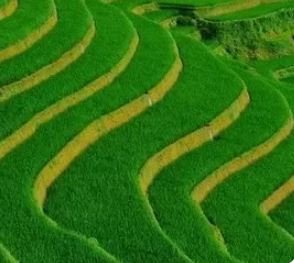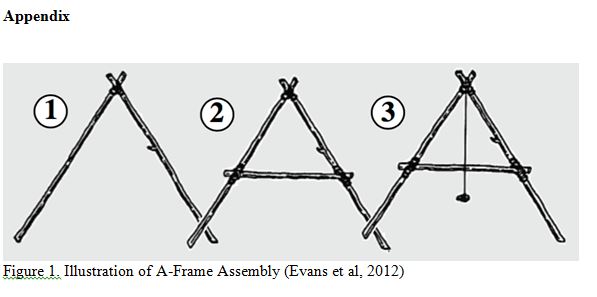Chapters 4.4
4.4 - Contour farming on hillsides to prevent erosion
Colton Lanthier, University of Guelph, Canada
Suggested citation for this chapter.
Lanthier,C. (2022) Contour farming on hillsides to prevent erosion. In Farmpedia, The Encyclopedia for Small Scale Farmers. Editor, M.N. Raizada, University of Guelph, Canada. http://www.farmpedia.org
Background
Soil degradation and erosion is one of the most prominent issues that subsistence farmers face. Impacts of soil erosion are wide ranging, and the amount of erosion around the world has been accelerated due to human activity. In South Africa for example, recent studies show that soil has eroded at 12.6 tons/ha/year under cropland whereas natural soil erosion is 5 tons/ha/year (Le Roux & Smith, 2014). In India, over 45% of all geographical surface area (130 million hectares) is seriously affected by soil erosion (India Netzone, 2012). Simpson (2010) defined soil degradation as, “ (the) decline in the productive capacity of the soil as a result of soil erosion and adverse changes in the hydrological, biological, chemical and physical properties of the soil.” It is also worth mentioning that soil erosion has impacts ranging much further than the agricultural sector. Although the immediate impacts can be felt on the farm with the loss of soil fertility and stability, the effects of erosion can leave communities in a state of chronic hunger, can flood lowland plains as sediment fills river systems, and can ruin the land for future generations of subsistence farmers (Simpson, 2010).
Contour farming is a simple, yet underused practice to prevent erosion along hillsides. The practice consists of sowing crops in rows, perpendicular to the slope (Sussman, 2007). It improves yields and greatly reduces soil erosion, including preserving soil fertility along slopes and works best in combination with hedgerows. This is a low cost, low labour practice that requires few materials that are often readily available on the farm already. Additionally, the practice of contour farming is easy to teach and once a farmer is comfortable with the process they are able to further demonstrate the practice to others farming on sloping lands. Contour farming consists of measuring lines perpendicular to the hillside and planting crops along these lines. The use of an A-Frame device can help quickly identify these lines and furthermore improve yields immediately.
Process
Implementing contour farming is the most labour intensive part of the practice. It begins by assembling an A-frame. This tool is used to mark out level pathways perpendicular to the slope of the hill. A level pathway is a measured line across a hillslope that farmers identify in order to plant their crops on level ground even when attempting to cultivate on a hillside (Sussman, 2007). An A-frame is easy to make and can use locally found materials. To make an A-frame one will need two poles around two meters long, another shorter pole about one meter long, some string and a stone (Evans et al, 2012). To assemble the A-frame, the two-meter poles and the one-meter pole need to be tied tightly (or nailed if available) together in the shape of a letter A. Once the poles have been connected use the rope to hang a stone from the top of the frame so that it hangs below the cross bar (Evans et al, 2012). Refer to Figure 1 for an illustration. This tool is used to measure out contour lines by marking out level pathways perpendicular to the slope of the hill.
After the contour lines have been marked its time to prepare hedgerows. Hedgerows allow uphill water to absorb into the hillside as opposed to running down the slope washing away nutrient rich soil (Evans et al, 2012). An optional intervention is the use of ditches which help in erosion prevention, irrigation, and cash crop yields. Hedgerows can be created by digging ditches along the previously marked contour lines, for an illustration as the how the process appears, refer to Figure 2 of the appendix. The ditches should be about 60 cm wide and 30 cm deep. The distance between hedgerows down a hillside is determined by the gradient of the slope. Refer to Table 1 for guidance. When excavating the ditches farmers are taught to dig from an uphill position as to maintain structural integrity of the uphill slope (Sussman, 2007). As the ditches are carved out the excavated sediment is to be placed downslope along the edge of the trench and packed in to create berms. Another optional intervention is to plant grasses, legumes or perennials along the berms as their root structures are capable of holding the berms in place and in the long run eases labour for the farmers, as they will no longer need to repair the berms after harvest. It is advised to mulch the berms while the roots develop over the first few seasons to maintain berm integrity (Sussman, 2007). If a farmer elects to plant legumes or perennials, such as pigeon peas or cassava, the farmer can harvest these vegetables to either consume or sell for money (Humphries, 2000).
Labour, Time, and Materials Involved
The most labour intensive aspect of contour farming, as previously mentioned, is the initial stages of preparing the land. After the contours have been marked, the ditches excavated, and the berms packed and mulched, substantial additional labour is not required. Sussman (2007) reported that contour farming requires little maintenance from season to season, with the most labour intensive aspect of this practice being the periodic removal of collected sediment in the trenches. The benefit of clearing this sediment, other than maintaining the integrity of the hedgerows, would be transporting the collected sediment to the top of the slope. The transported sediment highly fertile as it would have been collecting nutrients from organic matter, as it is the top layer of soil.
The materials required to run a successful contour and hedgerow practice would be the aforementioned A-frame device for measuring and leveling purposes, stakes are used to mark out contour lines, and shovels, hoes, or other tools used to dig out the trenches.
Benefits of Reducing Soil Erosion
By using hedgerows to catch rainwater this in turn prevents soil erosion from occurring. This is beneficial to farmers as it saves valuable nutrients in the soil from being washed away during heavy rainfall seasons. Steudel et al (2015) reported that contour banks (hedgerow berms) increased trapping capabilities by as much as 90% compared to hillsides with no soil conservation approaches. Reducing erosional discharge allows for intact soil and berms to absorb water and increase nutrient intake to the roots of crops, again improving yields (Simpson, 2010). By using these approaches to prevent soil erosion and degradation a farmer can preserve soil fertility and integrity for generations.
Farmers are influenced to measure the rate at which their hillside farms erode using a “Jumbie” (Simpson, 2010). A Jumbie is a metal rod or a stick that is driven into the ground to a depth between 30-60cm, or to the point in which it is securely anchored into the land. Placing multiple Jumbies evenly down and across a slope allows a farmer to figure out where along the hill needs the most maintenance and treatment. The farmer is to make a mark on the Jumbie where the tip protrudes from the ground. Farmers should check the Jumbies monthly and compare how much more of the tip is exposed compared to the previous markings. Hudson (1987) documented that 1mm of soil depth change measured is equivalent to the loss of 15 tons of sediment per acre per year. This figure further represents the importance of implementing contour plowing and hedgerows into a hillside farm. Therefore, Jumbies are a simple yet effective method to demonstrate to farmers the severity of erosion and the effects it can have.
Problems
The challenge for farmers to adopt this practice is the labour and time required to integrate contour farming into their practice. Humphries et al (2000) brought to light the idea of sensitizing farmers to the issue of soil degradation. This is a problem that requires government assistance to overcome. Without the population of farmers cultivating on a hillside becoming aware of the importance of maintaining soil fertility they will not be in a hurry to alter their traditional farming practices.
Another problem that arises in regards to hillside contour farming is the gradient of the slope the farmer is trying to cultivate. Contour plowing and hedgerow implementation is an extraordinarily effective method for reducing soil erosion and degradation and improves harvest yields but is only effective to a certain point. Referring to Table 1 again, the highest degree of the slope this practice is useful for is up until 33 degrees (Sussman, 2007). Beyond that measurement the contour lines would have to be measured too closely together in order to reap the benefits of the practice. Additionally, it becomes increasingly difficult to have livestock assisted labour as the slope a farmer chooses to cultivate becomes steeper and steeper.
Picture Based Lesson to Train Farmers
For the South Asian version (pictures only, text for you to insert), click this link for lesson 5.4:http://www.sakbooks.com/uploads/8/1/5/7/81574912/5.4_south_asian.pdf.
For the East/South Asian version (pictures only, text for you to insert), click this link for lesson 5.4:http://www.sakbooks.com/uploads/8/1/5/7/81574912/5.4e.s.a.pdf
For the Sub-Saharan Africa/Caribbean version (pictures only, text for you to insert), click this link for lesson 5.4:http://www.sakbooks.com/uploads/8/1/5/7/81574912/5.4subsaharan_africa_carribean.pdf
For the Latin-America version (pictures only, text for you to insert), click this link for lesson 5.4:http://www.sakbooks.com/uploads/8/1/5/7/81574912/5.4latin_america.pdf
For North Africa And Middle East version (pictures only, text for you to insert), click this link for lesson Chapter 5. 4.3:http://www.sakbooks.com/uploads/8/1/5/7/81574912/4.3n._africa_middleeast.pdf
Source: MN Raizada and LJ Smith (2016) A Picture Book of Best Practices for Subsistence Farmers. eBook, University of Guelph Sustainable Agriculture Kit (SAK) Project, June 2016, Guelph, Canada.
Additional Readings and Information
The following link will direct the reader to an informative and descriptive video produced by CropLife (a global organization in the plant science industry (CropLife, 2016) on their efforts to teach and implement contour farming practices in the Philippines. https://www.youtube.com/watch?v=fpdcEf-npr4.
This link will bring the reader to a simple manual describing and further illustrating the process of contour farming and hedgerow construction. http://www.bebuffered.com/downloads/sussman_contour_trenches.pdf.
References
1."About." CropLife International. N.p., 2016. Web. 23 Nov. 2016.
2.Evans, Chris, Laxman Rana, Hari Dhungana, and Malati Lakoul. The Farmers' Handbook, Part 5 - "Forest, Soil and Other Topics" Kathmandu: Formatting Printing, 2012. Print.
3.Hudson, Norman. Soil and Water Conservation in Semi-arid Areas. Rome: Food and Agriculture Organization of the United Nations, 1987. Print.
4.Keeble, V. B., Correll, L., & Ehrich, M. (1996). Effect of Laundering on Ability of Glove Fabrics to Decrease the Penetration of Organophosphate Insecticides Through in vitro Epidermal Systems. J. Appl. Toxicol. Journal of Applied Toxicology, 16(5), 401-406. doi:10.1002/(sici)1099-1263(199609)16:53.3.co;2-6
5.Humphries, Sally, Juan Gonzales, Jose Jimenez, and Fredy Sierra. Searching for Sustainable Land Use Practices in Honduras: Lessons from a Programme of Participatory Research with Hillside Farmers. London: Overseas Development Institute, 2000. Agricultural Research and Extension Network. Web.
6.Le Roux, Jay, and Hendrick Smith. "Soil Erosion in South Africa - Its Nature and Distribution." Soil Erosion in South Africa - Its Nature and Distribution. Grain SA, Nov. 2014. Web. 02 Dec. 2016.
7.Simpson, Leslie A. "A Manual of Soil Conservation and Slope Cultivation." Mainstreaming and Capacity Building for Sustainable Land Management (2010): 9-30. Print.
8."Soil Erosion in India." Soil Erosion in India. India Netzone, 30 Nov. 2012. Web. 02 Dec. 2016.
9.Steudel, Thomas, Richard Bugan, Holm Kipka, Pfennig, Manfred Fink, Willem DeClercq, Wolfgang-Albert Flugel, and Helmschrot. "Implementing Contour Bank Farming Practices into the J2000 Model to Improve Hydrological and Erosion Modelling in Semi-arid Western Cape Province of South Africa." Hydrology Research 46.2 (2015): 192. Web.
10.Sussman, Daniel. Design Manual: Contour Trenches (n.d.): n. pag. University of California Santa Barbara, 2007. Web.




